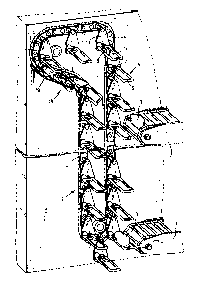Some of the information on this Web page has been provided by external sources. The Government of Canada is not responsible for the accuracy, reliability or currency of the information supplied by external sources. Users wishing to rely upon this information should consult directly with the source of the information. Content provided by external sources is not subject to official languages, privacy and accessibility requirements.
Any discrepancies in the text and image of the Claims and Abstract are due to differing posting times. Text of the Claims and Abstract are posted:
| (12) Patent: | (11) CA 1302944 |
|---|---|
| (21) Application Number: | 1302944 |
| (54) English Title: | EGG-TRANSPORTING APPARATUS |
| (54) French Title: | DISPOSITIF POUR LE TRANSPORT DES OEUFS |
| Status: | Term Expired - Post Grant |
| (51) International Patent Classification (IPC): |
|
|---|---|
| (72) Inventors : |
|
| (73) Owners : |
|
| (71) Applicants : | |
| (74) Agent: | SMART & BIGGAR LP |
| (74) Associate agent: | |
| (45) Issued: | 1992-06-09 |
| (22) Filed Date: | 1986-07-11 |
| Availability of licence: | N/A |
| Dedicated to the Public: | N/A |
| (25) Language of filing: | English |
| Patent Cooperation Treaty (PCT): | No |
|---|
| (30) Application Priority Data: | ||||||
|---|---|---|---|---|---|---|
|
ABSTRACT
This invention relates to an apparatus for receiving,
transporting and releasing eggs more particularly in
poultry-breeding operations, the said apparatus comprising a
plurality of cages arranged one above the other in storeys and
egg-collecting belts in front of each storey of cages, an
egg-elevator being arranged in the vicinity of the outlet-end of
each egg-collecting belt, the said elevator comprising a circulating
conveyor-chain carrying small supporting frames which are adapted to
the size of the eggs and to which the eggs are transferred from the
egg-collecting belt, the said supporting frames being secured
pivotably to the said conveyor-chain.
Note: Claims are shown in the official language in which they were submitted.
Note: Descriptions are shown in the official language in which they were submitted.

2024-08-01:As part of the Next Generation Patents (NGP) transition, the Canadian Patents Database (CPD) now contains a more detailed Event History, which replicates the Event Log of our new back-office solution.
Please note that "Inactive:" events refers to events no longer in use in our new back-office solution.
For a clearer understanding of the status of the application/patent presented on this page, the site Disclaimer , as well as the definitions for Patent , Event History , Maintenance Fee and Payment History should be consulted.
| Description | Date |
|---|---|
| Inactive: Expired (old Act Patent) latest possible expiry date | 2009-06-09 |
| Inactive: Reversal of will be deemed expired status | 2007-07-26 |
| Inactive: Office letter | 2007-07-26 |
| Letter Sent | 2007-06-11 |
| Inactive: Entity size changed | 2002-04-30 |
| Inactive: Entity size changed | 1998-06-01 |
| Grant by Issuance | 1992-06-09 |
There is no abandonment history.
| Fee Type | Anniversary Year | Due Date | Paid Date |
|---|---|---|---|
| MF (category 1, 6th anniv.) - small | 1998-06-09 | 1998-05-22 | |
| MF (category 1, 7th anniv.) - small | 1999-06-09 | 1999-06-09 | |
| MF (category 1, 8th anniv.) - small | 2000-06-09 | 2000-05-08 | |
| MF (category 1, 9th anniv.) - small | 2001-06-11 | 2001-03-29 | |
| MF (category 1, 10th anniv.) - standard | 2002-06-10 | 2002-04-18 | |
| MF (category 1, 11th anniv.) - standard | 2003-06-09 | 2003-03-21 | |
| MF (category 1, 12th anniv.) - standard | 2004-06-09 | 2004-05-26 | |
| MF (category 1, 13th anniv.) - standard | 2005-06-09 | 2005-05-19 | |
| MF (category 1, 14th anniv.) - standard | 2006-06-09 | 2006-05-19 | |
| MF (category 1, 15th anniv.) - standard | 2007-06-11 | 2007-05-29 | |
| MF (category 1, 16th anniv.) - standard | 2008-06-09 | 2008-05-26 |
Note: Records showing the ownership history in alphabetical order.
| Current Owners on Record |
|---|
| JOSEF KUHLMANN |
| Past Owners on Record |
|---|
| None |